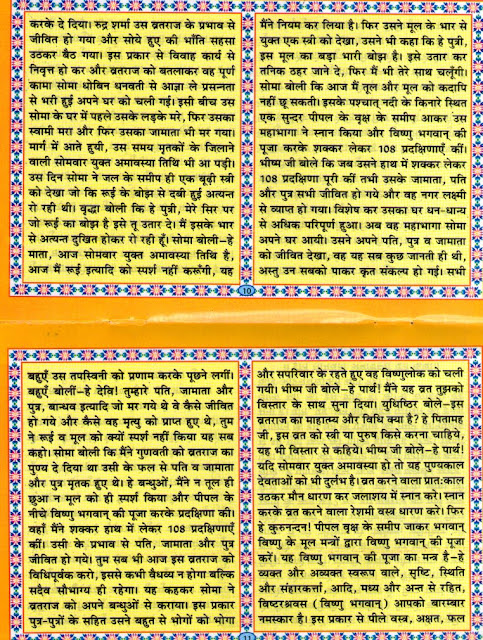Somvati Amavasya 2014 date, pitra moksha amavasya 2014, Somvati Amavasya pooja process ritual, Somvati Amavasya katha, Somvati Amavasya women fast ladies female, When is Somvati Amavasya Date,festival
01 January (Wednesday) Paush Amavasya
30 January (Thursday) Magha Amavasya
01 March (Saturday) Phalguna Amavasya
30 March (Sunday) Chaitra Amavasya
29 April (Tuesday) Vaishakha Amavasya
28 May (Wednesday) Jyaishta Amavasya
27 June (Friday) Ashadha Amavasya
26 July (Saturday) Shravana Amavasya
25 August (Monday) Bhadrapada Amavasya
24 September (Wednesday) Ashwin Amavasya
23 October (Thursday) Kartik Amavasya
22 November (Saturday) Margashirsha Amavasya
21 December (Sunday) Paush Amavasya
For Somvati Amavasya / pitra moksha amavasya Katha Click here
The Significance of Somvati Amavasya was narrated toYudhishtra by Bhisma in the Mahabharata. It is said that who ever takes a bath in the sacred rivers on the day would be prosperous, free of diseases and would be free from grief and sorrow. There is also a popular belief that the soul of ancestors will rest in peace if children and relatives take a holy dip in the sacred rivers.
Having a dip in Brahma Sarovar of Kurukshetra gives auspicious fruits to a person on this day. This gives inexhaustible fruits. From sunrise to sunset, crowd of people can be seen bathing in holy river. Echo of sacred verse is spread in all directions. Performing these works fulfils all wishes of an individual.
Women observing the fast of Somvati Amavasya should hear the fast story.
Process of the Pooja and Fast
The process and things required to do Somvati Amavasya Pooja is as mentioned below in the katha pages.
01 January (Wednesday) Paush Amavasya
30 January (Thursday) Magha Amavasya
01 March (Saturday) Phalguna Amavasya
30 March (Sunday) Chaitra Amavasya
29 April (Tuesday) Vaishakha Amavasya
28 May (Wednesday) Jyaishta Amavasya
27 June (Friday) Ashadha Amavasya
26 July (Saturday) Shravana Amavasya
25 August (Monday) Bhadrapada Amavasya
24 September (Wednesday) Ashwin Amavasya
23 October (Thursday) Kartik Amavasya
22 November (Saturday) Margashirsha Amavasya
21 December (Sunday) Paush Amavasya
About Somvati Amavasya
Amavasya of any month which falls on Monday is called Somvati Amavasya. It is specially known for the Tarpan of ancestors. Person observing this fast should sit under the Peepal tree and chant the Shani mantra on this day.
Baths and donations performed on Somvati Amavasya have a special significance. Staying Maun (silent) is very fruitful on this day. According to Dev Rishi Vyas, staying Maun and performing baths and donation give virtues similar to donating thousand cows.
Additionally, person observing fast revolves 108 times around Peepal tree and offers Puja to lord Vishnu and the tree. This fast is mainly observed by women. After this, donations are made according to the capabilities. On Somvati Amavasya, thousands of people could be seen having a dip in Haridwar. The Significance of Somvati Amavasya was narrated toYudhishtra by Bhisma in the Mahabharata. It is said that who ever takes a bath in the sacred rivers on the day would be prosperous, free of diseases and would be free from grief and sorrow. There is also a popular belief that the soul of ancestors will rest in peace if children and relatives take a holy dip in the sacred rivers.
Having a dip in Brahma Sarovar of Kurukshetra gives auspicious fruits to a person on this day. This gives inexhaustible fruits. From sunrise to sunset, crowd of people can be seen bathing in holy river. Echo of sacred verse is spread in all directions. Performing these works fulfils all wishes of an individual.
Women observing the fast of Somvati Amavasya should hear the fast story.
Process of the Pooja and Fast
The process and things required to do Somvati Amavasya Pooja is as mentioned below in the katha pages.


































